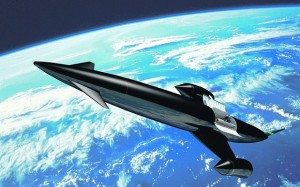Oxfordshire-based Reaction Engines are developing a new aerospace engine class that combines both jet and rocket technologies. They call it the greatest advance in propulsion since the jet engine which will help potentially revolutionizing hypersonic flight and dramatically reducing the cost of space access. SABRE, which stands for Synergetic Air-Breathing Rocket Engine, is designed to enable aircraft to operate from a standstill on the runway to hypersonic flight in the atmosphere, and then transition to rocket mode for spaceflight. Its Sabre engines for commercial air travel can go from zero to five times the speed of sound, and up to 25 times the speed of sound for space travel. Experts believe hypersonic air travel could enable people to one day journey anywhere in the world within four hours. “What we’re developing here is a revolutionary new form of propulsion, and it’s designed for low-cost space access and hypersonic air travel,” explained Reaction Engines’ Managing Director, Mark Thomas. “It’s a synthesis of rocket and jet engine technologies. It’s a device that would power a vehicle to more than five times the speed of sound, so more than 4,000 miles-per-hour, and up to 20 times the speed of sound if it’s going into orbit,” he added. Previous attempts to build single stage to orbit propulsion systems have been hampered by the weight of an on-board oxidizer, such as liquid oxygen, that is needed by conventional rocket engines. Reaction Engines’ idea was to design a device that could use the oxygen already present in the atmosphere through combustion like an ordinary jet engine.
“The biggest issue that the guys have had to wrestle with is how you cope with extremely high temperatures that come into the engine when you’re doing hypersonic speeds so more than five times the speed of sound, 4,000 miles-per-hour. The temperature coming in at the front of the engine is a thousand degrees centigrade. And you have to be able to cool that air very rapidly to be able to do anything useful with it,” said Thomas. Head of Advanced Manufacturing, Simon Hanks, said SABRE is the first engine in the world to successfully build an on-board oxidizer that uses the oxygen in the atmosphere via its pre-cooler technology. This rapidly cools the incoming airstream in the blink of an eye. “Essentially, it is an extremely efficient heat exchanging system, which will effectively mount on the front of our new engine design and very efficiently cool incoming air of a very high temperature of about a thousand degrees C [Centigrade], to minus 150 degrees C in a fraction of a second, approximately one-hundredth of a second,” said Hanks. He added that the state-of-the-art high vacuum furnace at their headquarters in Oxfordshire is being used to fuse together the complex matrices that make up their pre-cooler module. “We’re using here some technology to high-vacuum braise a much larger version of this (pre-cooler module) together. We’re operating at about one ten-billionth of an atmosphere at very high temperatures approaching a thousand degrees to achieve this joining process, which is very much unique to Reaction Engines.”
Once built, their technology will allow SABRE-powered vehicles to save carrying hundreds of tons of on-board oxidant on their way to orbit, and negate the need for first-stage rockets that are jettisoned once the oxidant is used up. The company says this could lead to a ten-fold saving in the cost of sending a craft into space, which currently costs about 100 million dollars. To demonstrate how the SABRE engine could make space access much easier, Reaction Engines have come up with the concept Skylon spaceplane. It’s an unpiloted, reusable vehicle that would be capable of transporting 15 tonnes of cargo into space. “The concept of a re-usable space plane is the Holy Grail of space access. But it’s incredibly difficult to pull off, and one of the reasons is designs up to this point have relied on multiple forms of propulsion, so jet engines, ramjets and rockets. If you can combine all the best elements of those propulsion systems in a single device, which is what we have in our SABRE engine, then you have a much more realistic proposition and a much greater chance of achieving that reusable space access,” explained Thomas. Reaction Engines say SABRE has undergone extensive independent testing by the European Space Agency (ESA). They have confirmed the viability of the test engine technology and its potential vehicle applications. With the investment from both BAE Systems and the UK government, the company is committed to having a full engine demonstration by the end of the decade. This will be a precursor to the development of a space access vehicle, but Mark Thomas said there is no limit to its potential applications.”The range of operation is extraordinary. There’s not another engine anywhere in the world even in people’s imagination that can achieve that range of operation. So that’s what really makes it unique.”
For more information please visit: www.reactionengines.co.uk

